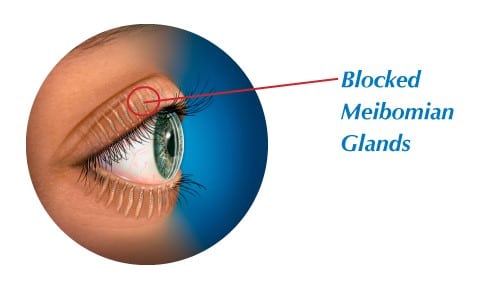What is Meibomian Gland Dysfunction?
Latest studies show that over 70% of Dry Eyes are caused by a problem with the oily part of the tear film. Glands on each eyelid produce this oily component, but far too often these glands become blocked.
This eye condition is known as Meibomian Gland Dysfunction or MGD.

Dry eye is
a very common condition that is characterised by a disturbance of the tear film. It causes a variety of symptoms and signs that often interfere with quality of life. To keep the eyes comfortable and provide optimal vision, a thin, healthy film of tears coats the surface of the eye. This tear film is made up of three layers:
- Lipid (oily) layer
- Aqueous (watery) layer
- Mucus (sticky) layer
In a healthy tear film, these three layers work together to protect and lubricate the eye.
The most superficial (top) layer is a very thin layer of lipids (fats and oils). These lipids are produced by the meibomian glands – a row of specialised oil glands along the edge of each eyelid.
The main function of this lipid layer is to prevent or decrease evaporation of the aqueous (watery) tear layer beneath. If the meibomian glands do not function properly, this leads to evaporative dry eye – where the watery tear layer has no protection from evaporating.
More About MGD
MGD occurs when the function of the oil-producing glands in the eyelids is impaired.
- This may be due to blepharitis, where the eyelid margins become inflamed and crusted.
- Certain medications can affect the secretions of these glands and cause them to block. Some acne medications such as Roaccutane and other drugs can have this effect.
- An imbalance of Omega-3 and -6 fatty acids in the body can also lead to impaired function of the glands.
- Contact lens wear is also associated with meibomian gland dysfunction. Whether this is due to the cleaning solutions or the contact lenses themselves is still under investigation.
- Certain skin conditions, such as acne rosacea, are also associated with impaired gland function.
Symptoms of MGD
Sticky or crusted eyelid margins, around the base of the eyelashes
Dry, red, sore, irritated or gritty eyes
Contact lens discomfort and eventually intolerance
It is estimated that over 70% of dry eye disease is caused or worsened by meibomian gland dysfunction, so it is imperative to treat the disorder effectively.
How is MGD treated?
- LipiFlow: This is the gold standard professional treatment for MGD. It applies heat and massage to the eyelids and can effectively kick start an effective dry eye treatment program.
- Intense Pulsed Light (IPL)
- BlephEx (in conjunction with Lid debridement): This is a professional clean of the eyelid margins and can be a great preparation for LipiFlow.
- Meibomian Gland expression: This is a manual expression of the secretions that are blocking the meibomian glands.
- Omega 3s: Changes in our modern diet mean we now consume far more omega 6 oils (in vegetable and seed oils) and less omega 3 oils (from seafood and other sources) than we did in the past.
Where we once consumed Omega 3s and 6s in roughly even quantities, these days we consume far (up to 20 times) more omega 6s at the expense of omega 3s. This shift is thought to be responsible for changes in the makeup of our cells, resulting in an epidemic of health problems – including MGD. Addressing the balance by increasing omega 3s in your diet, or taking an omega 3 supplement, can make a difference to your symptoms from the inside out.
Home therapies
- Warm Compress: Apply a warm compress to the eyes for 10 minutes before you go to bed. A gentle heated gel pack or wheat back is ideal, with a clean tissue placed across the closed eyes before applying.
- Lid Scrubs: Keeping the eye lid margins scrupulously clean is very important for dry eye sufferers. It is common to get itchy, red and flaky lid margins and any residue collecting on the lash-line can harbour the bacteria that cause redness and irritation.
- We always recommend using a purpose-designed product to gently and safely dissolve away the material that crusts along the edges of your lids. The Eye Practice stocks Sterilid and Blephadex for home use.
The foamy solution is applied either with the fingertips or with the provided wipes (depending on the product). Like the warm compresses above, it is recommended to use lid scrubs daily for several weeks to get the problem under control and then ease back into a maintenance regime of once or twice a week.
It is worth noting that this eye condition is not simple to treat and is often caused by multiple factors working in tandem.
For an assessment of your tear function and an effective treatment program for underlying concerns, including Meibomian Gland Dysfunction, call us on (02) 9290 1899 and make an appointment today.
 Dry eye is a very common condition that is characterised by a disturbance of the tear film. It causes a variety of symptoms and signs that often interfere with quality of life. To keep the eyes comfortable and provide optimal vision, a thin, healthy film of tears coats the surface of the eye. This tear film is made up of three layers:
Dry eye is a very common condition that is characterised by a disturbance of the tear film. It causes a variety of symptoms and signs that often interfere with quality of life. To keep the eyes comfortable and provide optimal vision, a thin, healthy film of tears coats the surface of the eye. This tear film is made up of three layers:

